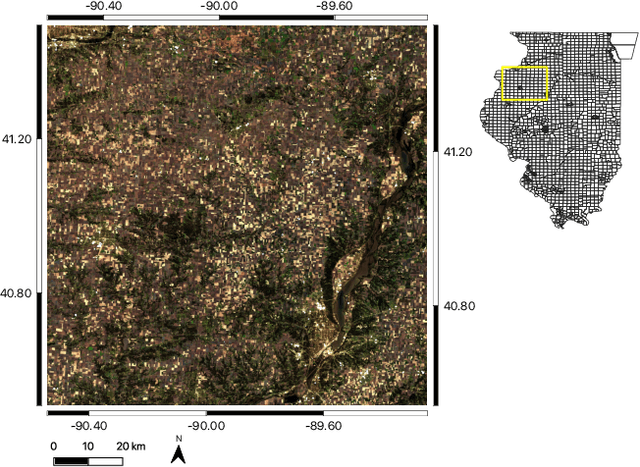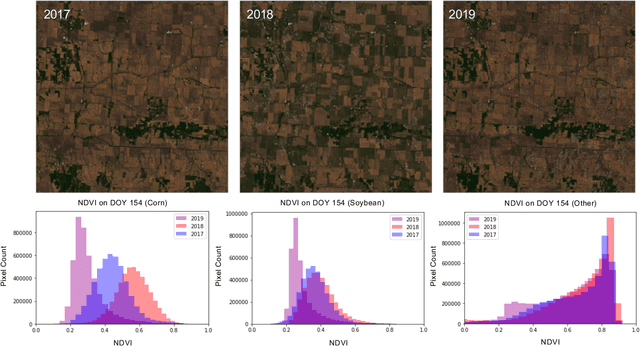Inbal Becker-Reshef
How accurate are existing land cover maps for agriculture in Sub-Saharan Africa?
Jul 05, 2023Abstract:Satellite Earth observations (EO) can provide affordable and timely information for assessing crop conditions and food production. Such monitoring systems are essential in Africa, where there is high food insecurity and sparse agricultural statistics. EO-based monitoring systems require accurate cropland maps to provide information about croplands, but there is a lack of data to determine which of the many available land cover maps most accurately identify cropland in African countries. This study provides a quantitative evaluation and intercomparison of 11 publicly available land cover maps to assess their suitability for cropland classification and EO-based agriculture monitoring in Africa using statistically rigorous reference datasets from 8 countries. We hope the results of this study will help users determine the most suitable map for their needs and encourage future work to focus on resolving inconsistencies between maps and improving accuracy in low-accuracy regions.
Improve State-Level Wheat Yield Forecasts in Kazakhstan on GEOGLAM's EO Data by Leveraging A Simple Spatial-Aware Technique
Jun 01, 2023Abstract:Accurate yield forecasting is essential for making informed policies and long-term decisions for food security. Earth Observation (EO) data and machine learning algorithms play a key role in providing a comprehensive and timely view of crop conditions from field to national scales. However, machine learning algorithms' prediction accuracy is often harmed by spatial heterogeneity caused by exogenous factors not reflected in remote sensing data, such as differences in crop management strategies. In this paper, we propose and investigate a simple technique called state-wise additive bias to explicitly address the cross-region yield heterogeneity in Kazakhstan. Compared to baseline machine learning models (Random Forest, CatBoost, XGBoost), our method reduces the overall RMSE by 8.9\% and the highest state-wise RMSE by 28.37\%. The effectiveness of state-wise additive bias indicates machine learning's performance can be significantly improved by explicitly addressing the spatial heterogeneity, motivating future work on spatial-aware machine learning algorithms for yield forecasts as well as for general geospatial forecasting problems.
* Accepted to (ICLR) 2023 Workshop on Machine Learning for Remote Sensing
Resilient In-Season Crop Type Classification in Multispectral Satellite Observations using Growth Stage Normalization
Sep 21, 2020



Abstract:Crop type classification using satellite observations is an important tool for providing insights about planted area and enabling estimates of crop condition and yield, especially within the growing season when uncertainties around these quantities are highest. As the climate changes and extreme weather events become more frequent, these methods must be resilient to changes in domain shifts that may occur, for example, due to shifts in planting timelines. In this work, we present an approach for within-season crop type classification using moderate spatial resolution (30 m) satellite data that addresses domain shift related to planting timelines by normalizing inputs by crop growth stage. We use a neural network leveraging both convolutional and recurrent layers to predict if a pixel contains corn, soybeans, or another crop or land cover type. We evaluated this method for the 2019 growing season in the midwestern US, during which planting was delayed by as much as 1-2 months due to extreme weather that caused record flooding. We show that our approach using growth stage-normalized time series outperforms fixed-date time series, and achieves overall classification accuracy of 85.4% prior to harvest (September-November) and 82.8% by mid-season (July-September).
Rapid Response Crop Maps in Data Sparse Regions
Jun 23, 2020



Abstract:Spatial information on cropland distribution, often called cropland or crop maps, are critical inputs for a wide range of agriculture and food security analyses and decisions. However, high-resolution cropland maps are not readily available for most countries, especially in regions dominated by smallholder farming (e.g., sub-Saharan Africa). These maps are especially critical in times of crisis when decision makers need to rapidly design and enact agriculture-related policies and mitigation strategies, including providing humanitarian assistance, dispersing targeted aid, or boosting productivity for farmers. A major challenge for developing crop maps is that many regions do not have readily accessible ground truth data on croplands necessary for training and validating predictive models, and field campaigns are not feasible for collecting labels for rapid response. We present a method for rapid mapping of croplands in regions where little to no ground data is available. We present results for this method in Togo, where we delivered a high-resolution (10 m) cropland map in under 10 days to facilitate rapid response to the COVID-19 pandemic by the Togolese government. This demonstrated a successful transition of machine learning applications research to operational rapid response in a real humanitarian crisis. All maps, data, and code are publicly available to enable future research and operational systems in data-sparse regions.
Field-Level Crop Type Classification with k Nearest Neighbors: A Baseline for a New Kenya Smallholder Dataset
Apr 06, 2020



Abstract:Accurate crop type maps provide critical information for ensuring food security, yet there has been limited research on crop type classification for smallholder agriculture, particularly in sub-Saharan Africa where risk of food insecurity is highest. Publicly-available ground-truth data such as the newly-released training dataset of crop types in Kenya (Radiant MLHub) are catalyzing this research, but it is important to understand the context of when, where, and how these datasets were obtained when evaluating classification performance and using them as a benchmark across methods. In this paper, we provide context for the new western Kenya dataset which was collected during an atypical 2019 main growing season and demonstrate classification accuracy up to 64% for maize and 70% for cassava using k Nearest Neighbors--a fast, interpretable, and scalable method that can serve as a baseline for future work.
 Add to Chrome
Add to Chrome Add to Firefox
Add to Firefox Add to Edge
Add to Edge